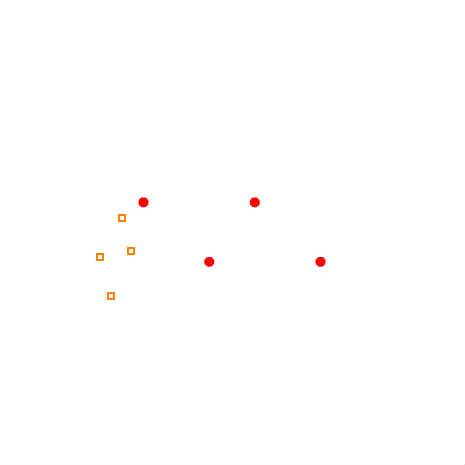forked from: forked from: Fast texture extraction
forked from forked from: Fast texture extraction (diff: 157)
Testing projected shape behavior (yet again sucks).
ActionScript3 source code
/**
* Copyright makc3d ( http://wonderfl.net/user/makc3d )
* MIT License ( http://www.opensource.org/licenses/mit-license.php )
* Downloaded from: http://wonderfl.net/c/cT5i
*/
package {
import flash.display.Bitmap;
import flash.display.BitmapData;
import flash.display.Loader;
import flash.display.LoaderInfo;
import flash.display.Sprite;
import flash.events.Event;
import flash.events.MouseEvent;
import flash.geom.Point;
import flash.net.URLRequest;
import flash.system.LoaderContext;
/**
* Testing projected shape behavior (yet again sucks).
*/
[SWF(width=465,height=465,backgroundColor=0)]
public class HTest extends Sprite {
public var anchors:Vector.<Anchor>;
public var homography:Homography;
public function HTest () {
anchors = new Vector.<Anchor> (4, true);
addChild (anchors [0] = new Anchor (100, 257));
addChild (anchors [1] = new Anchor (122, 218));
addChild (anchors [2] = new Anchor (131, 251));
addChild (anchors [3] = new Anchor (111, 296));
addChild (homography = new Homography);
homography.x = homography.y = 232;
stage.addEventListener (MouseEvent.MOUSE_MOVE, onMouseMove);
onMouseMove (null);
}
public function onMouseMove (e:MouseEvent):void {
if ((e == null) || e.buttonDown) {
homography.update (
new Point (anchors [0].x, anchors [0].y),
new Point (anchors [1].x, anchors [1].y),
new Point (anchors [2].x, anchors [2].y),
new Point (anchors [3].x, anchors [3].y)
);
}
}
}
}
import flash.display.Sprite;
import flash.events.MouseEvent;
class Anchor extends Sprite {
public function Anchor (x0:int, y0:int) {
x = x0; y = y0;
graphics.beginFill (0xFF7F00, 1);
graphics.drawRect (-4, -4, 8, 8);
graphics.drawRect (-2, -2, 4, 4);
graphics.beginFill (0xFF7F00, 0);
graphics.drawRect (-2, -2, 4, 4);
useHandCursor = buttonMode = true;
addEventListener (MouseEvent.MOUSE_DOWN, startDragMe);
addEventListener (MouseEvent.MOUSE_UP, stopDragMe);
}
public function startDragMe (e:MouseEvent):void {
startDrag ();
}
public function stopDragMe (e:MouseEvent):void {
stopDrag ();
}
}
/**
* And now we use a method by Mark Lundin
* @see https://gist.github.com/658176
*/
import flash.display.BitmapData;
import flash.display.Graphics;
import flash.display.Shape;
import flash.geom.Matrix3D;
import flash.geom.Point;
import flash.geom.Vector3D;
class Homography extends Shape {
public function update (
p0:Point, p1:Point, p2:Point, p3:Point,
halfWidth:int = 232, halfHeight:int = 232):void {
// Find diagonals intersection point
var pc:Point = new Point;
var a1:Number = p2.y - p0.y;
var b1:Number = p0.x - p2.x;
var a2:Number = p3.y - p1.y;
var b2:Number = p1.x - p3.x;
var denom:Number = a1 * b2 - a2 * b1;
if (denom == 0) {
// something is better than nothing
pc.x = 0.25 * (p0.x + p1.x + p2.x + p3.x);
pc.y = 0.25 * (p0.y + p1.y + p2.y + p3.y);
} else {
var c1:Number = p2.x * p0.y - p0.x * p2.y;
var c2:Number = p3.x * p1.y - p1.x * p3.y;
pc.x = (b1 * c2 - b2 * c1) / denom;
pc.y = (a2 * c1 - a1 * c2) / denom;
}
p0 = p0.subtract (pc);
p1 = p1.subtract (pc);
p2 = p2.subtract (pc);
p3 = p3.subtract (pc);
var m:Matrix3D = HomographyUtil.findHomography (
Vector.<Point> ([
new Point (-1, -1),
new Point (1, -1),
new Point (1, 1),
new Point (-1, 1)
]),
Vector.<Point> ([
p0, p1, p2, p3
])
);
var v0:Vector3D = m.transformVector (new Vector3D (-1, -1, 1));
var v1:Vector3D = m.transformVector (new Vector3D (1, -1, 1));
var v2:Vector3D = m.transformVector (new Vector3D (1, 1, 1));
var v3:Vector3D = m.transformVector (new Vector3D (-1, 1, 1));
// find any orthogonal basis in the plane
var u:Vector3D = new Vector3D (v1.x - v0.x, v1.y - v0.y, v1.z - v0.z);
var v:Vector3D = new Vector3D (v1.x - v2.x, v1.y - v2.y, v1.z - v2.z);
var scale:Number = 200 / (u.length + v.length);
var w:Vector3D = u.crossProduct (v); v = w.crossProduct (u);
u.normalize (); v.normalize ();
w.x = 0.25 * (v0.x + v1.x + v2.x + v3.x);
w.y = 0.25 * (v0.y + v1.y + v2.y + v3.y);
w.z = 0.25 * (v0.z + v1.z + v2.z + v3.z);
v0 = v0.subtract (w);
v1 = v1.subtract (w);
v2 = v2.subtract (w);
v3 = v3.subtract (w);
graphics.clear ();
graphics.beginFill (0xFF0000);
graphics.drawCircle (
u.dotProduct (v0) * scale,
v.dotProduct (v0) * scale,
5
);
1.
graphics.drawCircle (
u.dotProduct (v1) * scale,
v.dotProduct (v1) * scale,
5
);
graphics.drawCircle (
u.dotProduct (v2) * scale,
v.dotProduct (v2) * scale,
5
);
graphics.drawCircle (
u.dotProduct (v3) * scale,
v.dotProduct (v3) * scale,
5
);
}
}
/**
*
* @author Mark Lundin
*
* Based upon code provided by nicoptere - http://www.nicoptere.net/AS3/homographie/blog/Homography.as
* The findHomography now computes a Matrix3D that maps the transformation between two sets of complanar points.
* The transformation finds the a mapping from the source quad to a unit square,
* and a second mapping from a unit square to the destination quad.
* An adjoint is then found for the second matrix and the two multiplied together.
*
* Standard vectors3d points can be transformed against this matrix.
* Divide by the z component to map to a coordinate in the uv plane.
*
*/
class HomographyUtil
{
public static function findHomography( source:Vector.<Point>, destination:Vector.<Point> ):Matrix3D
{
/*
* This can probably be optimized. Its using a very simple and straightforward equation
*
* Mapping is quad -> unit square -> quad. This should probably skip out the unit square and go straight from quad to quad
*/
var sourceHomography : Matrix3D = HomographyUtil.getSystem( destination );
var destHomography : Matrix3D = HomographyUtil.adjoint( HomographyUtil.getSystem( source ) );
destHomography.append( sourceHomography );
return destHomography;
}
public static function getSystem( points:Vector.<Point> ):Matrix3D
{
var sx:Number = (points[0].x - points[1].x) + (points[2].x - points[3].x);
var sy:Number = (points[0].y - points[1].y) + (points[2].y - points[3].y);
var dx1:Number = points[1].x - points[2].x;
var dx2:Number = points[3].x - points[2].x;
var dy1:Number = points[1].y - points[2].y;
var dy2:Number = points[3].y - points[2].y;
var z:Number = (dx1 * dy2) - (dy1 * dx2);
var g:Number = ((sx * dy2) - (sy * dx2)) / z;
var h:Number = ((sy * dx1) - (sx * dy1)) / z;
var a:Number = points[1].x - points[0].x + g * points[1].x;
var b:Number = points[3].x - points[0].x + h * points[3].x;
var c:Number = points[0].x;
var d:Number = points[1].y - points[0].y + g * points[1].y;
var e:Number = points[3].y - points[0].y + h * points[3].y;
var f:Number = points[0].y;
var homography:Vector.<Number> = new Vector.<Number>( 16, true );
homography[0] = a; homography[4] = b; homography[8] = c; homography[12] = 0;
homography[1] = d; homography[5] = e; homography[9] = f; homography[13] = 0;
homography[2] = g; homography[6] = h; homography[10] = 1; homography[14] = 0;
homography[3] = 0; homography[7] = 0; homography[11] = 0; homography[15] = 0;
return new Matrix3D( homography );
}
public static function adjoint ( matrix : Matrix3D ) : Matrix3D
{
var adj:Vector.<Number> = new Vector.<Number>( 16, true);
var m:Vector.<Number> = matrix.rawData;
var a:Number = m[0];
var b:Number = m[1];
var c:Number = m[2];
var d:Number = m[4];
var e:Number = m[5];
var f:Number = m[6];
var g:Number = m[8];
var h:Number = m[9];
adj [ 0 ] = e-f*h; adj [ 4 ] = f*g-d; adj [ 8 ] = d*h-e*g; adj [ 12 ] = 0;
adj [ 1 ] = c*h-b; adj [ 5 ] = a-c*g; adj [ 9 ] = b*g-a*h; adj [ 13 ] = 0;
adj [ 2 ] = b*f-c*e; adj [ 6 ] = c*d-a*f; adj [ 10 ] = a*e-b*d; adj [ 14 ] = 0;
adj [ 3 ] = 0; adj [ 7 ] = 0; adj [ 11 ] = 0; adj [ 15 ] = 1;
return new Matrix3D( adj );
}
}

